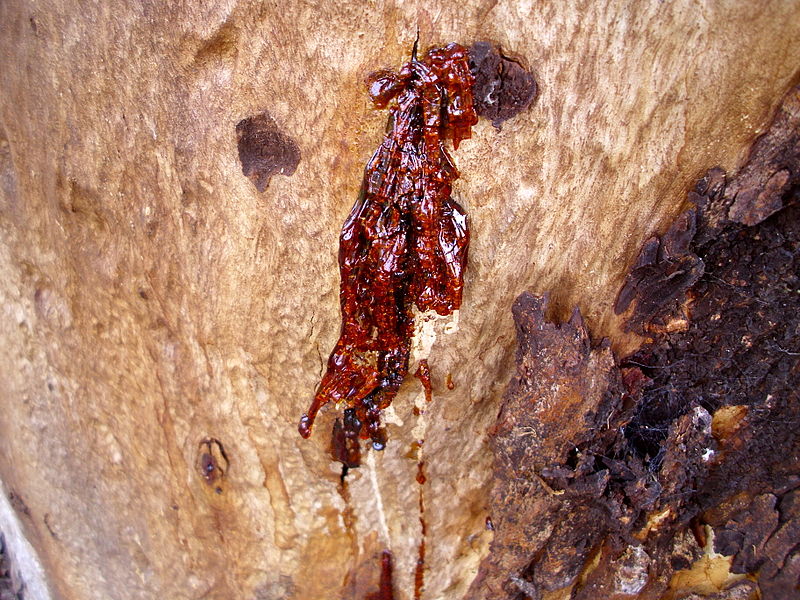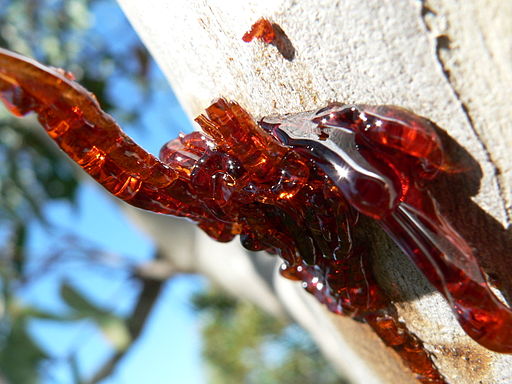A medium sized tree with a deciduous, smooth, grey-white bark; its timber
is red. Juvenile leaves are opposite with a slightly bluish appearance, narrow
to broad and tapered at both ends, 6-9 cm long and 2.5-4 cm broad; mature leaves
are alternate, narrow, tapered at both ends and usually slightly sickle-shaped,
12-22 cm long and 0.8-1.5 cm wide; they are relatively thin and green on both
sides, except in some arid country forms. The fruit is hemispherical to almost
globular with a broad rim and entirely protuding valves, about 6-7 mm in diameter.
Flowers nearly all year round.
[1] Potter's New Cyclopaedia of Botanical
Drugs and Preparations R.C. Wren Revised by Elizabeth M. Williamson and
Fred J Evans. First published in Great Britain in 1988 and reprinted in 1989
and 1994 by the C. W. Daniel Company Limited. 1 Church Path, Saffron Walden
Essex. Published 1988 Printed and bound by Biddles, Guildford ISBN 085207 1973.
[2] Reid, E. and Betts, T. J. The Records of Western Australian Plants Used
by Aboriginals as Medicinal Agents; Western Australian Institute of Techology,
Pharmacy Department, 1977.
[3] Red, E. J. and Betts, T. J.
Planta Medica, 36, 164 (1979)
[4] J.H. Maiden, The Florest Flora of New South Wales, Vol. 7 Government Printer,
Sydney, 1911
[5] A. Campbell, Australian Journal of Pharmacy, 894 (1973)
[6] The Merck Index. 7th edition, Merck & Co. Inc., Hahway, M.J. 1960
Images
1.
commons.wikimedia.org
by Bidgee CC SA 3.0 Australia
2.
au.pinterest.com Kinos of the following species are also
useful as astringents for the treament of diarrhea.[1]
E. crebra, E. saligna (both belonging to the gummy group)- 10% solution
in water; dose is about 150 g of solution every day.[1]
E. acmenioides, E. tereticornis 5% solution in water is used internally.[1]
E. microcorys (turbid group of kinos).[1]
Stronger solutions are used if they are applied externally to sores and the
like.[1]
References
[1] Australian Medicinal Plants- E.V. Lassak & T. McCarthy. Publisher- Reed
New Holland, Australia 1983. ISBN 1876334703.
Volatile oil; containing citronellal ~ 70%.[1]
Tannins[1,2] ~ 40%; kinotannic acid,[1,6]
catechol,[1,6] pyrocatechol,[1,6]
and "kino red".[1]
References
[1] Drogenkunde, 8th Ed. Heinz, A., Hoppe. Pub. W. de Gruyter (1975) Berlin
[2] Reid, E. J., Betts, T. J., Planta Medica, 36, 164 (1979)
[3] The Merck Index. 7th edition, Merck & Co. Inc., Hahway, M.J. 1960
 Eucalyptus
camaldulensis. Eucalyptus rostrata- River
red gum and many other species of Eucalyptus
Eucalyptus
camaldulensis. Eucalyptus rostrata- River
red gum and many other species of Eucalyptus